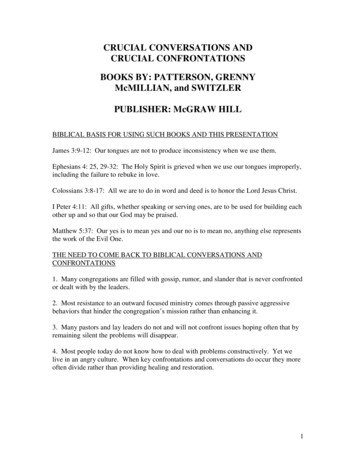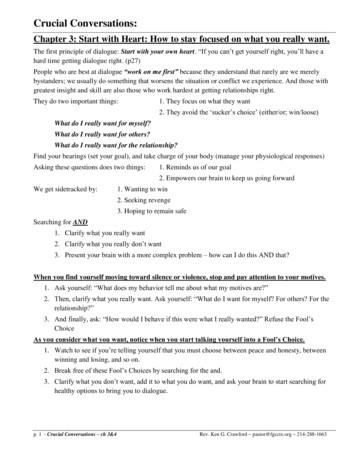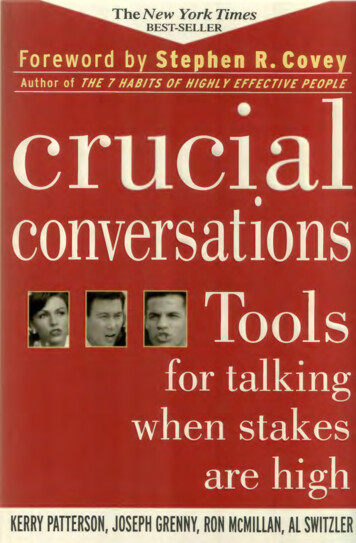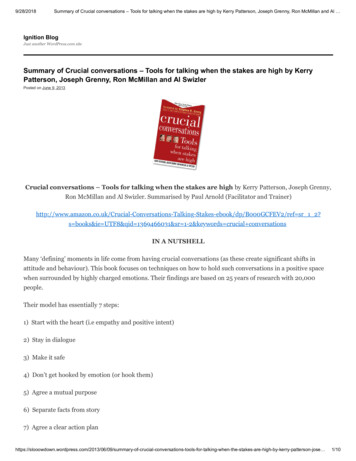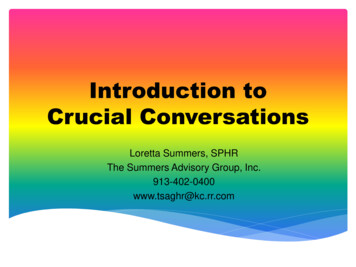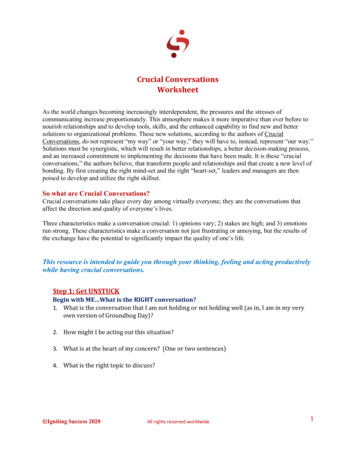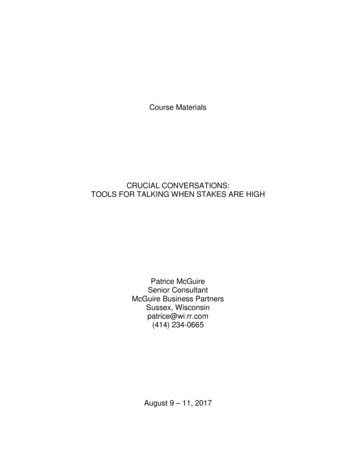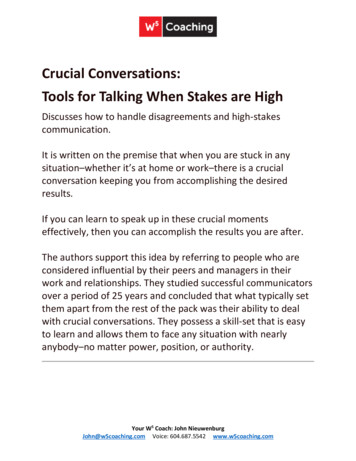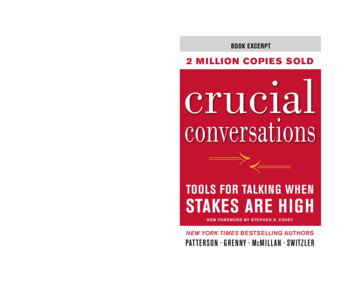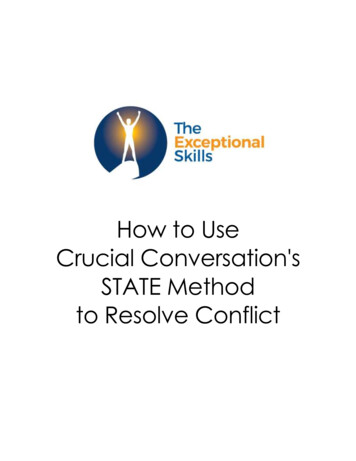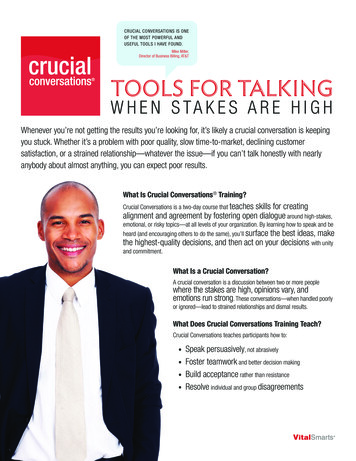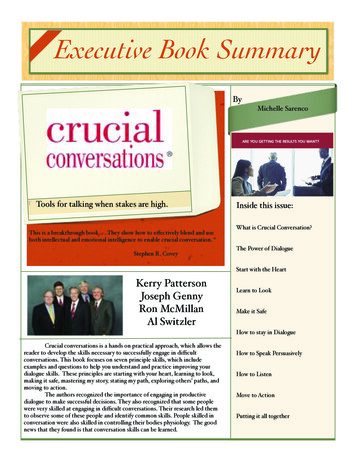
Transcription
Executive Book SummaryByMichelle SarencoTTools for talking when stakes are high.This is a breakthrough book. . . They show how to effectively blend and useboth intellectual and emotional intelligence to enable crucial conversation. “Stephen R. CoveyInside this issue:What is Crucial Conversation?The Power of DialogueStart with the HeartKerry PattersonJoseph GennyRon McMillanAl SwitzlerLearn to LookMake it SafeHow to stay in DialogueCrucial conversations is a hands on practical approach, which allows thereader to develop the skills necessary to successfully engage in difficultconversations. This book focuses on seven principle skills, which includeexamples and questions to help you understand and practice improving yourdialogue skills. These principles are starting with your heart, learning to look,making it safe, mastering my story, stating my path, exploring others’ paths, andmoving to action.The authors recognized the importance of engaging in productivedialogue to make successful decisions. They also recognized that some peoplewere very skilled at engaging in difficult conversations. Their research led themto observe some of these people and identify common skills. People skilled inconversation were also skilled in controlling their bodies physiology. The goodnews that they found is that conversation skills can be learned.How to Speak PersuasivelyHow to ListenMove to ActionPutting it all together
What’s a Crucial ConversationA crucial conversation can take placeany time any where. It is those everydayconversations that affect our lives.Definition:“Crucial ConversationA discussion between two or morepeople where (1) Stakes are high, (2)opinions vary and (3) emotions runstrong.” (p. 3)Three options for handle crucialconversations.1 We can avoid them.2. We can face them and handle thempoorly.3. We can face them and handle themwell.Physiological responses occur whenwe encounter these conversations.Adrenaline is pumped into our bodywhich causes the brain to direct ourblood flow to the larger muscles,while blood is reduced to nonessential parts of the brains thatcontrols higher reasoning.Dr. Glaser and Dr. Glaser’s researchshows that people who can mastercrucial conversations are healthier andlive longer.One of the first things you need to dois refocus your brain. Asking yourselfquestions helps to refocus back ondialogue.Power of DialogueAsking yourself what you want helpsyou to take charge of the physiology ofyour body. When we ask ourselves achallenging question it causes thebrain to recognize that we are not inphysical danger and it moves theblood away from the major musclesand back to the brain.“Dialogue - The free flow of meaningbetween two people” (p. 20).Thoughts and feelings formulate ourmeaning that drives our actions.A person skilled at dialogue makes it asafe environment for everyone toshare their information.When everyone shares their ideas andinformation, it allows for moreaccurate information and thereforebetter choices.Curly says: If you want to succeed inlife you have to do one thing.DialogueHow of DialogueCommitment and action come fromdecisions made when people havebeen involved in meaningful dialogue.Dialogue skills can be learnedWhat do I really want for myself ?What do I really want for others?What do I really want for the relationship?How would I behave if I really wanted theseresults?Start with HeartThe only person you can control isyourself.So asking yourself what you reallywant serves two purposes. It keepsyour focused on your goals and it helpsthe body’s physiology.The only person you can control isyourself.Avoid sucker choices. These includebelieving you are choosing betweenpeace and honesty, or winning andlosing and so on.When faced with what could be asucker choice, work on formulating anand question. The and question ismade up of two parts. First is aquestion that clarifies what you wantand the second part clarifies what youdon’t want. ie) “How can I have acandid conversation with my husbandabout being more dependable andavoid creating bad feelings or wastingour time?” (p. 41)And questions cause people to becomemore reflective and engaged in thedialogue.
Learn to LookLearn to look for the content andconditions of the conversation.When people become emotional in theconversation they tend to focus on thecontent of the conversation and forget towatch for the conditions.Conditions to look for include spottingwhen a conversation is becoming crucial,looking for safety problems, andrecognizing your style under stress.Recognizing when a conversation isbecoming crucial involves recognizingphysical, emotional or behavioral signsoccurring in your body. These couldinclude such signs as stomach tightening,or an angry feeling.When people are feeling safe they willengage in dialogue. Not feeling safecaused people to head down one of twopaths. They either move to silence or toviolence.Often we fail to monitor our ownbehavior. We become consumed with thecontent and we fail to notice ourselvessaying or acting in inappropriate ways.Watch to see if others are turningtowards silence or violence, as well asyourself.FightFlightConsists of any verbal attempt toconvince, control or compel others toyour point of view.Seen as silence, which causes theperson to actively withholdinformation that could add to thedialogue.Three most common forms of violenceare:Controlling: coercing others to yourway of thinking.Labeling: dismissing others by puttinga label on them.Attacking: move from winning tomaking the person suffer. Belittling orthreatening.Three most common forms of silenceare:Masking: includes sarcasm,sugarcoating or couching.Avoiding: steering away from thesensitive subject.Withdrawing: pulling out of theconversation.Step out to make it Safe.Step out of the content of the conversation. You do this to allow yourself theopportunity to look at others reactions and your own responses. Look to see ifsafety is at risk. Dialogue will not occur if people are feeling unsafe. Identifywhich safety condition is at risk.1. Mutual Purpose - working toward a common outcome in the conversation.When purpose is at risk it often is seen in both parties debating.2. Mutual Respect- is the continuance condition of dialogue. When people feelthey are not being respected it causes the dialogue to stop and defending ofdignity takes over. Look for peoples with highly charged emotions.
What to do to make it Safe.ApologizeContrastA statement that sincerely expressesyour sorrow for causing pain or difficultyto another person.Contrasting is a do/don’t statementthat addresses the other personsconcern that you don’t respect them oryou have malicious intent. This is thedon’t part of a contrasting statement.A sincere apology involves a change ofheart.Watch to see if the apology has restoredsafety and trust so that dialogue maycontinue.CRIBThe do part of the statement confirmsthat you respect the person andclarifies your real purpose or intent.Contrasting is not apologizing. It isnot meant to take back what we saidbut help to ensure that what we saiddidn’t hurt more than what wasintended.Contrasting helps others to understandour intent in what we are saying.contrastCRIB is an acronymCommit to seek mutual purpose. Startwith heart by committing to stay inconversation. We need to stop thinkingthat our opinion is the only correctsolution. We need to open our mind toother peoples thoughts and ideas.Recognize the purpose behind thestrategy and the need to change ourstrategy.Invent a mutual purpose. You need tomore encompassing goals. This couldinclude focussing on longer term goals.Brainstorm new strategies. Join forces infinding a solution that benefits everyone.CRIB- Commit, Recognize, Invent, andBrainstorm.Master My StoriesHow to stay in Dialogue.When your angry, scared or hurt.Taking charge of your emotions.No one can make you feel anything, it is you who chooses what you are feeling.You can act on them or be acted on by them.If you are having difficulty moving away from responding with either silence of violence than you need to rethink youremotions and then retrace your path to action.Path to ActionSee/HearTell aStoryFeelNotice Your BehaviorActGet in touch with yourfeelings.Analyze your story.Get back to the facts.
State My PathHow to speak persuasively not abrasively.Share your factsTell Your StoryIt is the facts and your conclusion ofthe facts that make the dialogue.If you retrace your path of action to thesource, you arrive at your facts.Sharing your story takes confidence.Make sure that your story comesfrom a rational and reasonableexamination of the facts. Notjumping to conclusions.Start your conversation with anotherperson with the facts not the story wehaver created.Facts are the least controversial andmost persuasive component of aconversation.Facts lay the ground work for all crucialconversations.STATEThe first three tell what you should do andthe last two tell how you should do it.Ask for others’ pathsShare your factsTell your storyAsk for others’ pathsTalk tentativelyEncourage testingTalk TentativelyAsking for the others path helps todemonstrate humility.This means to tell your story at a story andnot to disguise it at fact.Carefully listen to what they have to say.You need to be confident in your storytelling but humble as well. Again do notassume that the story is fact.Be willing to abandon your or reshapeyour story based on what you are hearingthe other person say.Talking tentatively does not mean you aretalking as a wimp.Explore Others’PathsHow to listen when othersblow up or clam up.VSDon’t pile it on. Don’t let theproblem simmer for a long time. Thelonger you let it simmer the greaterthe mind wanders.Watch for the deterioration of safetyand use contrasting to help youremain in dialogue.Encourage testingHere you are encouraging others totalk and share their story.Invite opposing views. This givesgreater opportunity to add meaningto the pot of information.Be sincere when inviting others tospeak and listen to what they say.Use questions to encourage others tospeak up.This is another tool for helping others to feel safe in the conversation.When exploring others’ paths you need to be sincere. If you are sincere then youwill be ready and willing to become an active listener. Look for chances to turn onyour curiosity to understand the persons fear, anger or anxiety. This also helps you toremain calm by keeping your brain focused. It helps you to retrace the other person’spath so you can better understand how they came to their conclusions. Be patientwith the other people. Adrenalin can hang around in a person for a long time.There are four listening skills that can help you to retrace another persons path.Ask - this is expressing interest in another persons point of viewMirror- This involves acknowledging what the other person is feeling.Paraphrase- restate what you are hearing in order maintain understanding andencourage continued dialogue by the other person.Prime- If they will not engage then state your best guess at what they are feeling.ABC’s- agree when you do, build on the common understanding and compare yourtwo points of view.
Move to ActionHow to Turn Crucial Conversations into Action andResultsMoving to action doesn’t always work forMethods of Decision Makingthe following two reasons:Command1. There is an unclear expectation on howdecisions will be made.This is when decisions are made with no2. They do a poor job acting on theinvolvement. Outside forces demand thedecisions they do make.decision or the decision is turned over tosomeone else and we just follow along.Dialogue is not Decision MakingThe two riskiest times in crucialVoteconversations are at the beginning andthe end. In the beginning you are settingThis works best when you are choosingup a safe environment. At the endfrom a variety of good options andeverything needs to be clarified or youefficiency is the highest value.run the risk later on of expectationsbeing violated or inaction occurring.ConsultDecision makers invite others in to heartheir opinions prior to the decision beingmade.ConsensusYou talk until everyone honestly agreeswith one decision. Can produce greatsynergy. Should only be used wheneveryone must support the decision.How to ChooseThe people involved in the dialogueneed to decide how the decisions will bemade.Who Cares?Who Knows?Decide who really wants to be involved Decide who has expertise in the topic ofand who will be affected by the decision. the decision.Who Must Agree?Decide who’s cooperation do you needin regards to authority or influence.Making assignmentsPutting decisions intoactionsMake and clarify the plan ofactionDecide who does what?When it will be done by?How will you follow up?How many people toinvolve?Goal is to involve the fewest number ofpeople, while still considering thesupport needed.Decision Making Blunders and Solutions Don’t pass out orders like candy.When you face a command decision, ask which elements are flexible.When giving an order explain why.When engaging consulting don’t involve a lot of people if you have already madeup your mind.Announce what your doing.Report your decision.If holding a vote, weigh the consequences.know when to vote.Don’t cop out with a vote.Don’t force consensus onto everything.Don’t pretend that everyone gets their first choice.No martyrsDon’t take turns.Don’t engage in post decision lobbyingDon’t say “ I told you so”.
Putting it all Together
Personal CritiqueThis book is an excellent resource for learning how tokeep your composure, control your emotions and thinkthrough your actions and comments when you enterinto a difficult dialogue. Patterson, Genny, et al. have written a book that clearlydescribes seven principles to improve ones ability to engage in a difficult dialogue, while keepingtheir emotions in control. To demonstrate how to apply each of the seven principles, theyaccompany the principle with practical example and guiding questions. By practicing these questionsand actions one could improve their ability to communicate.This book focuses on how to control your physiological responses and it also teaches what tolook for in the people you are engaging in dialogue. It helps you to identify when the people aroundyou are feeling unsafe in the discussion and how you can step out of the conversation and restoresafety.This book can move you from failing at the tough conversations to a productive safe dialoguethat can provide a pool of information to use to make decisions.I highly recommend this book.
Crucial conversations is a hands on practical approach, which allows the reader to develop the skills necessary to successfully engage in difficult conversations. This book focuses on seven principle skills, which include examples and questions to help yo
